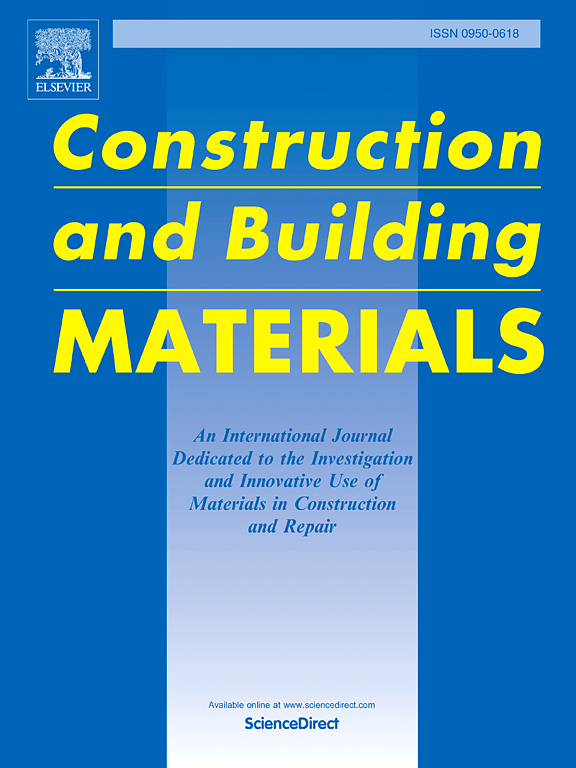Bound water evolution and machine-learning-assisted early hydration degree estimation of cement paste based on hyperspectral imaging
IF 8
1区 工程技术
Q1 CONSTRUCTION & BUILDING TECHNOLOGY
引用次数: 0
Abstract
The early hydration degree of cementitious materials affects their initial properties. This makes accurate hydration degree estimation necessary for a more precise reference for initial applications, particularly for various slag-blended cementitious materials. Hydration degree is closely related to bound water evolution. Accordingly, this study used the D-dry ignition method and near-infrared hyperspectral imaging (NIR-HSI) to establish the relationship between bound water evolution and spectral reflectance at different stages. The reflectance values in the 900–1700 nm wavelength generally increased as water was removed. By contrast, the 1390–1430 nm range exhibited a logarithmic decrease over time owing to the increase in hydration products. A linear relationship was observed between the bound water content and average reflectance within this wavelength range. In addition, an exponential relationship was found between the hydration rate and average reflectance difference. Several machine learning models, including the random forest (RF), backpropagation neural network (BPNN)–rectified linear unit (ReLU), gradient boosting decision tree (GBDT)–Huber, and radial basis function (RBF)–support vector machine (SVM), were used to estimate the hydration degree of the cement paste. The RF model demonstrated superior estimation accuracy and the most robust performance among all models. This study provides a new perspective for precisely estimating the hydration degree of cementitious materials within the context of data-driven science.
基于高光谱成像的水泥浆体结合水演化及机器学习辅助早期水化程度估算
胶凝材料的早期水化程度会影响其初始特性。因此有必要对水化度进行精确估算,以便为初始应用提供更精确的参考,特别是对于各种矿渣混合胶凝材料。水化度与结合水演化密切相关。因此,本研究采用 D 干点火法和近红外高光谱成像技术(NIR-HSI)建立了不同阶段结合水演化与光谱反射率之间的关系。随着水分的去除,900-1700 nm 波长范围内的反射率值普遍增加。相比之下,由于水合产物的增加,1390-1430 nm 波长范围内的反射率随时间呈对数下降。在此波长范围内,结合水含量与平均反射率之间呈线性关系。此外,还发现水合速率与平均反射率差异之间存在指数关系。几种机器学习模型,包括随机森林 (RF)、反向传播神经网络 (BPNN)-校正线性单元 (ReLU)、梯度提升决策树 (GBDT)-Huber 和径向基函数 (RBF)- 支持向量机 (SVM) 被用来估算水泥浆的水化程度。在所有模型中,RF 模型的估计精度更高,性能也最稳定。这项研究为在数据驱动科学背景下精确估算水泥基材料的水化度提供了一个新的视角。
本文章由计算机程序翻译,如有差异,请以英文原文为准。
求助全文
约1分钟内获得全文
求助全文
来源期刊

Construction and Building Materials
工程技术-材料科学:综合
CiteScore
13.80
自引率
21.60%
发文量
3632
审稿时长
82 days
期刊介绍:
Construction and Building Materials offers an international platform for sharing innovative and original research and development in the realm of construction and building materials, along with their practical applications in new projects and repair practices. The journal publishes a diverse array of pioneering research and application papers, detailing laboratory investigations and, to a limited extent, numerical analyses or reports on full-scale projects. Multi-part papers are discouraged.
Additionally, Construction and Building Materials features comprehensive case studies and insightful review articles that contribute to new insights in the field. Our focus is on papers related to construction materials, excluding those on structural engineering, geotechnics, and unbound highway layers. Covered materials and technologies encompass cement, concrete reinforcement, bricks and mortars, additives, corrosion technology, ceramics, timber, steel, polymers, glass fibers, recycled materials, bamboo, rammed earth, non-conventional building materials, bituminous materials, and applications in railway materials.
 求助内容:
求助内容: 应助结果提醒方式:
应助结果提醒方式:


